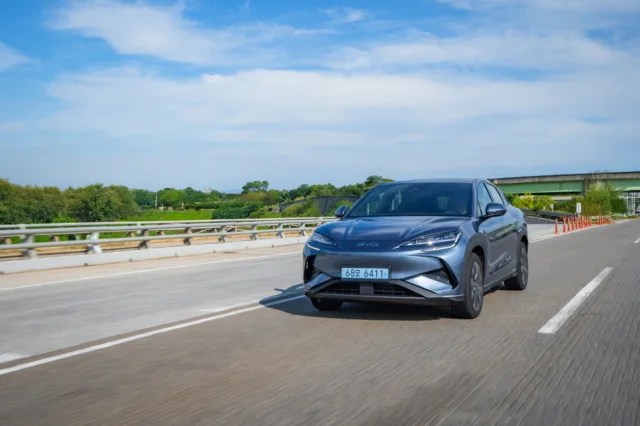
Launched in Korea in September, BYD’s electric SUV Sealion 7 sold 825 units in its debut month, becoming the fourth best-selling imported model in the country.
Offering comfortable driving performance at an accessible price, the Chinese EV maker’s third passenger model in Korea marks BYD’s breakthrough following sluggish sales of its first two models.
On Oct. 14, The Korea Herald test-drove the Sealion 7 over a 130-kilometer route between Suwon, Gyeonggi Province, and Dangjin, South Chungcheong Province. Despite heavy rain and low visibility, the sport utility vehicle demonstrated consistent comfort and stability throughout the night drive.
Measuring 4,830 millimeters in length and 1,925 mm in width, the midsize SUV gives a strong sense of volume, yet its curved lines and coupe-like rear create a soft impression. BYD Korea explained that the round body design also contributes to its relatively high aerodynamic efficiency, with a drag coefficient of 0.28.
Inside, the most eye-catching feature is the large 15.6-inch center display, which integrates nearly all physical buttons into the touchscreen for a clean and modern cockpit design.

The display provides one-touch access to a wide range of driving assistance systems through clear, intuitive icons, enabling drivers to adjust the level of regenerative braking for a more personalized driving experience.
The navigation screen required slightly more head movement to view compared to other models. However, the high-definition surround view cameras, which automatically activate in narrow lanes or during parking, are a clear advantage.
The seats provided good support and minimized fatigue throughout the three-hour drive. The cabin space also provided ample headroom and rear legroom, adding to overall comfort.
At low speeds, the vehicle felt slightly heavy, but overall, acceleration and braking were smooth. Combined with effective insulation from exterior noise and road vibration, it was easy to forget how fast the car was actually moving, even at speeds over 150 kilometers per hour.
Pitch and roll inside the cabin were well controlled during acceleration, braking and cornering — performing beyond what is typical in the SUV’s price segment.

The car’s cruise control maintained steady steering feedback, while the blind-spot collision warning system and the infrared sensor-based driver attention monitoring function also performed effectively. However, rear visibility was somewhat limited without a digital rearview mirror.
The driving range was the only modest letdown. With regenerative braking set to normal, the car used 18 percent of its battery over a 65-kilometer drive on a highway, where opportunities for energy recovery through deceleration or braking are minimal.
This indicates an estimated real-world range of around 361 kilometers per charge, compared to the official 398 kilometers certified for its 82.56-kilowatt-hour lithium iron phosphate battery.
The BYD Sealion 7 is currently offered in a single trim at 44.99 million won ($31,700), which can drop to the 30 million won range with government EV subsidies.

forestjs@heraldcorp.com









